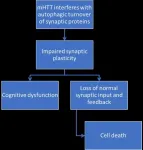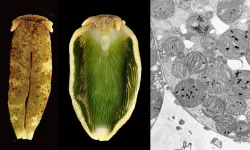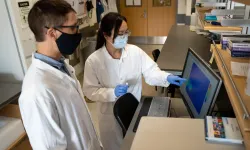(Press-News.org) BOSTON - New research led by investigators at Massachusetts General Hospital (MGH) and Massachusetts Eye and Ear indicates that the blood pressure drug losartan may benefit patients with neurofibromatosis type 2 (NF2), a hereditary condition associated with vestibular schwannomas, or noncancerous tumors along the nerves in the brain that are involved with hearing and balance. The findings, which are published in Science Translational Medicine, are especially important because vestibular schwannomas are currently treated with surgery and radiation therapy (which carry risks of nerve damage), and no drug is approved by the U.S. Food and Drug Administration to treat these tumors or their associated hearing loss.
"Developing effective therapeutics to preserve hearing function in patients with NF2 is an urgent unmet medical need. The greatest barrier to managing NF2-related auditory impairment is our incomplete understanding of how schwannomas cause hearing loss," says co-senior author Lei Xu, MD, PhD, an investigator in the Steele Laboratories for Tumor Biology within the MGH Department of Radiation Oncology. A previous report showing that scarring, or fibrosis, exists in schwannomas and correlates with hearing loss prompted the team to test whether a drug that blocks fibrosis might be effective.
Losartan blocks a component of the renin-angiotensin system, which is involved not only in regulating blood pressure but also in stimulating fibrosis and inflammation. The entire class of angiotensin-targeting drugs, which includes losartan, has been shown to reduce collagen accumulation in cardiac and kidney fibrotic disease. Using a mouse model of NF2, Xu and her colleagues found that losartan treatment had several effects on vestibular schwannomas and the brain: It reduced inflammatory signaling and swelling and thus prevented hearing loss, and it increased oxygen delivery to enhance the effectiveness of radiation therapy (which may help lower the radiation dose needed to control tumor growth and limit radiation-associated toxicities).
In preparation to translate these findings into the clinic, co-senior author Konstantina Stankovic, MD, PhD, former chief of the Division of Otology and Neurotology at Massachusetts Eye and Ear, now Bertarelli Professor and Chair of the Department of Otolaryngology - Head and Neck Surgery at Stanford University School of Medicine, examined patient samples and data. Her team found that vestibular schwannomas associated with poor hearing had more pronounced inflammatory signaling than tumors associated with good hearing. This inflammatory signaling in tumors was capable of directly damaging cochlear cells that are essential for hearing. Also, patients with vestibular schwannoma who took losartan or other drugs in its class experienced no progression in hearing loss, unlike patients on other or no antihypertensive drugs. This study illustrates the advantages offered by an integrated approach and teamwork that spans basic research, translational investigation and clinical care.
The findings support the need for a prospective clinical trial of losartan in patients with NF2 and vestibular schwannomas. "As one of the most commonly prescribed drugs for hypertension, the safety and low cost of losartan warrants rapid translation of our research to patients with vestibular schwannomas to try to prevent tumor-induced sensorineural hearing loss," Stankovic says.
INFORMATION:
Xu is an assistant professor at Harvard Medical School. Co-authors included Limeng Wu, Sasa Vasilijic, Yao Sun, Jie Chen, Lukas D. Landegger, Yanling Zhang, Wenjianlong Zhou, Jun Ren, Samuel Early, Zhenzhen Yin, William W. Ho, Na Zhang, Xing Gao, Grace Y. Lee, Meenal Datta, Jessica E. Sagers, Alyssa Brown,Alona Muzikansky, Anat Stemmer-Rachamimov, Luo Zhang, Scott R. Plotkin and Rakesh K. Jain.
This study was supported by the Department of Defense, the Children's Tumor Foundation Drug?Discovery Initiative, the National Cancer Institute, the Advanced Medical Research Foundation, Jane's Trust Foundation, the Lustgarten Foundation, the Ludwig Center at Harvard, the National Foundation for Cancer?Research, the Gates Foundation, the Cancer Research Institute, the American Association of Cancer Research, the National Institute on Deafness and Other Communication Disorders, Nancy Sayles Day Foundation, Lauer Tinnitus Research Center, the Barnes Foundation, the Zwanziger Foundation, and Sheldon and Dorothea Buckler.
About the Massachusetts General Hospital
Massachusetts General Hospital, founded in 1811, is the original and largest teaching hospital of Harvard Medical School. The Mass General Research Institute conducts the largest hospital-based research program in the nation, with annual research operations of more than $1 billion and comprises more than 9,500 researchers working across more than 30 institutes, centers and departments. In August 2020, Mass General was named #6 in the U.S. News & World Report list of "America's Best Hospitals."
About Mass Eye and Ear
Massachusetts Eye and Ear, founded in 1824, is an international center for treatment and research and a teaching hospital of Harvard Medical School. A member of Mass General Brigham, Mass Eye and Ear specializes in ophthalmology (eye care) and otolaryngology-head and neck surgery (ear, nose and throat care). Mass Eye and Ear clinicians provide care ranging from the routine to the very complex. Also home to the world's largest community of hearing and vision researchers, Mass Eye and Ear scientists are driven by a mission to discover the basic biology underlying conditions affecting the eyes, ears, nose, throat, head and neck and to develop new treatments and cures. In the 2020-2021 "Best Hospitals Survey," U.S. News & World Report ranked Mass Eye and Ear #4 in the nation for eye care and #6 for ear, nose and throat care. For more information about life-changing care and research at Mass Eye and Ear, visit our blog, Focus, and follow us on Instagram, Twitter and Facebook.
Amsterdam, July 15, 2021 - Huntington's Disease (HD) is a progressive neurodegenerative condition characterized by motor, cognitive, and psychiatric symptoms, and motor symptoms are often preceded by cognitive changes. Recent evidence indicates that autophagy plays a central role in synaptic maintenance, and the disruption in autophagy may be at the root of these early cognitive changes. Understanding this mechanism better may help researchers develop treatments for patients with HD early in their disease progression, report scientists in a review article published in the Journal of Huntington's Disease.
In this review, experts describe how autophagy, the cellular process responsible ...
We sleep on average one third of our time. But what does the brain do during these long hours? Using an artificial intelligence approach capable of decoding brain activity during sleep, scientists at the University of Geneva (UNIGE), Switzerland, were able to glimpse what we think about when we are asleep. By combining functional magnetic resonance imaging (fMRI) and electroencephalography (EEG), the Geneva team provides unprecedented evidence that the work of sorting out the thousands of pieces of information processed during the day takes place during ...
The COVID-19 pandemic halted the in-person wintertime survey of wolves and moose on the island for the first time in 63 years. Consequently, there are no estimates of wolf or moose abundance for 2021, and the next estimates are scheduled in February 2022. But though the Isle Royale Winter Study didn't happen quite as planned, researchers were still able to visit the remote national park in the spring.
Now, fieldwork has resumed and Michigan Technological University researchers have already uncovered new information about these two iconic wildlife populations. In particular, wolves produced at least two litters of pups, and moose appear poised for decline.
In the Isle Royale Winter Study, Michigan ...
Plants, algae and some bacteria are able to perform photosynthesis, which is the process of transforming sunlight energy into sugar. Animals are generally unable to use this process to acquire energy, but there are a few known exceptions to this. Some sea slugs take up chloroplasts from the algae that they consume into their cells. These chloroplasts retain their ability to perform photosynthetic activity within the animal cells for several months, and thus provide them with photosynthesis-derived nutrition. This process is called "kleptoplasty", and it has attracted much attention due to its amazing uniqueness in making animals photosynthetic for over 50 years.
A pressing question is how these sequestered chloroplasts retains their photosynthetic capability without algal nuclei. ...
Since the Paris Climate Agreement that took effect in 2016, 121 countries have pledged to become carbon neutral by 2050 as the world tries to reduce its fuel consumption. The Korean government also unveiled its 2050 Carbon Neutral Strategy on December 7, 2020 and declared Carbon Zero, making transition to new and renewable energy a topic of conversation. Recently, a joint research team from POSTECH and Korea University has developed a radiative cooling material that can reduce energy consumption by selectively reflecting or transmitting sunlight.
A research team led by Professor Junsuk Rho, Ph.D. candidate Minkyung Kim, and Dr. Dasol Lee of POSTECH's departments of mechanical engineering and chemical engineering, and a team led by Professor Heon Lee and Soomin of the Department of Materials ...
Combined perceptions of the risk and availability of cannabis influence the risk of cannabis use more than perceived risk and perceived availability alone, according to a new study at Columbia University Mailman School of Public Health. Researchers observed that those who perceived cannabis as low-risk and available were more likely to report using the drug in the past year and almost daily compared to those individuals who perceived cannabis as high-risk and unavailable. This is the first study to consider the joint effects of perceived risk and perceived availability. The results are published in the journal Drug and Alcohol Dependence.
"Our study described the evolution of joint perceptions of cannabis risk and availability from 2002-2018 and estimated the relationship between combined ...
Adolescent girls and young women can and will use HIV prevention products with consistency, according to interim results of a study of two different methods: daily use of the antiretroviral (ARV) tablet Truvada® as oral pre-exposure prophylaxis (PrEP) and the monthly END ...
Shining a beam of light into potentially contaminated water samples may hold the key to real-time detection of hydrocarbons and pesticides in water.
UBC Okanagan researchers are testing the use of fluorescence to monitor water quality. The results, they say, show great promise.
When a beam of light is shone into the water, it excites the electrons in molecules of certain compounds and causes them to emit light. The characteristics of the emitted light are like a fingerprint and can be used to identify certain contaminants, explains Nicolas Peleato, an assistant professor at UBCO's School of Engineering.
"The challenge with using this fluorescence approach is that ...
Repairing complex electrical appliances is time consuming and rarely cost-effective. The working group led by Prof. Dr. Karl Mandel, Professorship of Inorganic Chemistry at Friedrich-Alexander-Universität Erlangen-Nürnberg (FAU), has now developed a smart microparticle that enables defective components in these appliances to be identified more quickly and easily by using light signals. In the long-term, this could make repairs easier and extend the operating life of devices. The results have been published in the journal Advanced Functional Materials.
To identify defective components in a device, particles known as supraparticles are applied to the individual parts. These particles measure between one and ten micrometres and under black light they provide information ...
Fukuoka, Japan--At this very moment, the billions of neurons in your brain are using their trillions of connections to enable you to read and comprehend this sentence.
Now, by studying the neurons involved in the sense of smell, researchers from Kyushu University's Faculty of Medical Sciences report a new mechanism behind the biomolecular bonsai that selectively strengthens these connections.
How neuronal circuits remodel themselves over time, especially during early development, is an open question in neurobiology. At the start of neuronal development, neurons form excessive amounts of connections ...





